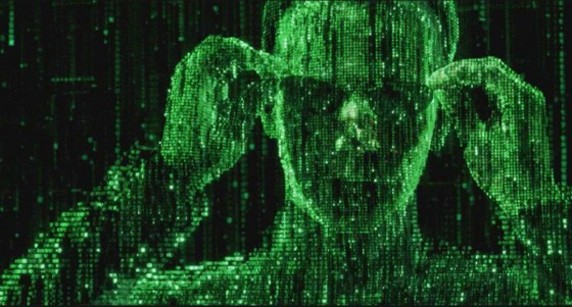User:Inge Hoonte/nov 14: Difference between revisions
Inge Hoonte (talk | contribs) |
Inge Hoonte (talk | contribs) |
||
| (5 intermediate revisions by the same user not shown) | |||
| Line 3: | Line 3: | ||
== Animating the terminal == | == Animating the terminal == | ||
Use the terminal as a screen or display for moving image by playing with the background image. Replace the background with a narrow (screenwidth) and super long jpg consisting of several still frames, placed underneath each other. Narrative develops from top to bottom. When you run a script over it, the background becomes an animated gif. Experiment with speed. How many frames flash by per second? Depends too on what you run on the page. Fill it with x's, a letter, a textual narrative? If you program an error, the terminal itself can produce a rhythmic sound. This happened the other day when I was playing with the clapping music, but unfortunately I haven't been able to re-enact/replicate/reproduce the mistake. | Use the terminal as a screen or display for moving image by playing with the background image. Replace the background with a narrow (screenwidth) and super long jpg consisting of several still frames, placed underneath each other. Narrative develops from top to bottom. When you run a script over it, the background becomes an animated gif. Experiment with speed. How many frames flash by per second? Depends too on what you run on the page. Fill it with x's, a letter, a textual narrative? If you program an error, the terminal itself can produce a rhythmic sound. This happened the other day when I was playing with the clapping music, but unfortunately I haven't been able to re-enact/replicate/reproduce the mistake. | ||
Looking at processes inside the terminal as instructions for performances. The desktop and graphical interface as mere visual translation of a standard office desktop. Literally interacting with the little person living inside your computer, who helps you complete assignments. I keep having that graphic in mind, how files used to be copied, the animation that transports a leaf of paper from one physical folder to the other. Physically, this could be a bike messenger, or a mailman by foot, transporting a stack of paper from one side of town to the other. As it is done leaf by leaf, it would be a lot of biking or walking back and forth! | |||
Sources: [http://stackoverflow.com/questions/2076380/linux-terminal-animation-best-way-to-delay-printing-of-frame-in-c animation in c] | Sources: [http://stackoverflow.com/questions/2076380/linux-terminal-animation-best-way-to-delay-printing-of-frame-in-c animation in c] | ||
| Line 32: | Line 34: | ||
Cropped out of the image is Echo, his longing admirer, her attraction left unanswered. In this analogy - water as screen - I suppose Echo could refer to someone trying to get your attention while you're on the computer, phone, etc? The bigger outside world vs inner realm? | Cropped out of the image is Echo, his longing admirer, her attraction left unanswered. In this analogy - water as screen - I suppose Echo could refer to someone trying to get your attention while you're on the computer, phone, etc? The bigger outside world vs inner realm? | ||
Playing with this notion of interacting with and talking to your computer, befriending the machine, developing a relationship. The computer, the machine as extension of ourselves. '''The screen becoming a mirror.''' | |||
[[File:Narcissus_crop2.jpg]] [[File:narcissus.jpg]] | [[File:Narcissus_crop2.jpg]] [[File:narcissus.jpg]] | ||
[[File:Example.jpg]][[File:Neo.jpg]][[File:layingcomputerstare.jpg]] | |||
(Source: Corbis Images) | |||
[http://en.wikipedia.org/wiki/Trinity_%28The_Matrix%29 The Matrix] | |||
Computer programmers and hackers living within and outside the System. Before Neo was appointed as The One, he was a computer hacker sitting behind a computer for days, by himself, staring at a screen. Once he became activated and started traveling within the Matrix, he built relationships on each side of the dividing line. But what happens at the edge? | |||
* As always with learning new programs, you have to learn the language, the logic. With some people you have to watch your mouth, certain expressions might hurt them. Other people you might want to flatter or bring a smile to their face with a compliment. In terms of programming, and coding language, the punctuation is very important. One program needs ; where another program would find that too much decoration. Over time you learn its rigors, its riches, how to talk to it, how to charm it. | * As always with learning new programs, you have to learn the language, the logic. With some people you have to watch your mouth, certain expressions might hurt them. Other people you might want to flatter or bring a smile to their face with a compliment. In terms of programming, and coding language, the punctuation is very important. One program needs ; where another program would find that too much decoration. Over time you learn its rigors, its riches, how to talk to it, how to charm it. | ||
| Line 42: | Line 50: | ||
* Related to this are the poems I've been writing, which are logged on this wiki as well. They play with language and terms that are new to me, while at the same time building upon previous interests. | * Related to this are the poems I've been writing, which are logged on this wiki as well. They play with language and terms that are new to me, while at the same time building upon previous interests. | ||
* [http://www.allacademic.com//meta/p_mla_apa_research_citation/1/7/2/7/2/pages172721/p172721-1.php Computers Are People, Too: A New Perspective of Human-Computer Interaction] "This study extended the computers as social actors perspective and further asked the question: What kind of relationship people have developed with their computers. An online survey was conducted with 86 college students participated. The findings indicated that people might develop diverse relationships with their computers. The computer-computer relationship types identified in this study were: social relationship, working relationship, acquaintance, mixed relationship and enemy. The natures of these relationships were: warm, love-hate, neutral and cold. People also developed emotional ties with their computers. The interactions between human-computer relationship type, human-computer relationship nature, computer use and computer activities were examined. The finding suggested that human-computer relationship type and nature do influence computer use. This study proposed a new perspective on human-computer interaction. Theoretical and practical implications were discussed." | * [http://www.allacademic.com//meta/p_mla_apa_research_citation/1/7/2/7/2/pages172721/p172721-1.php Computers Are People, Too: A New Perspective of Human-Computer Interaction] "This study extended the computers as social actors perspective and further asked the question: What kind of relationship people have developed with their computers. An online survey was conducted with 86 college students participated. The findings indicated that people might develop diverse relationships with their computers. The computer-computer relationship types identified in this study were: social relationship, working relationship, acquaintance, mixed relationship and enemy. The natures of these relationships were: warm, love-hate, neutral and cold. People also developed emotional ties with their computers. The interactions between human-computer relationship type, human-computer relationship nature, computer use and computer activities were examined. The finding suggested that human-computer relationship type and nature do influence computer use. This study proposed a new perspective on human-computer interaction. Theoretical and practical implications were discussed." | ||
* Somewhat unrelated. In 1983, [http://books.google.nl/books?id=McPHBI0ghCIC&pg=PA410&lpg=PA410&dq=computer+human+inside+relationship&source=bl&ots=bGd3oy3RQQ&sig=FrQF-Xm2tVoFJ5bUKMKZUFrsgus&hl=nl&ei=sAngTMqTO47qOaPf7foO&sa=X&oi=book_result&ct=result&resnum=2&ved=0CCUQ6AEwAQ#v=onepage&q=computer%20human%20inside%20relationship&f=false Macintosh] saw women as new users, a new market, who had to be researched and designed for. | * Somewhat unrelated. In 1983, [http://books.google.nl/books?id=McPHBI0ghCIC&pg=PA410&lpg=PA410&dq=computer+human+inside+relationship&source=bl&ots=bGd3oy3RQQ&sig=FrQF-Xm2tVoFJ5bUKMKZUFrsgus&hl=nl&ei=sAngTMqTO47qOaPf7foO&sa=X&oi=book_result&ct=result&resnum=2&ved=0CCUQ6AEwAQ#v=onepage&q=computer%20human%20inside%20relationship&f=false Macintosh] saw women as new users, a new market, who had to be researched and designed for. | ||
Latest revision as of 23:29, 14 November 2010
(sc)rambles, kernels of projects
Animating the terminal
Use the terminal as a screen or display for moving image by playing with the background image. Replace the background with a narrow (screenwidth) and super long jpg consisting of several still frames, placed underneath each other. Narrative develops from top to bottom. When you run a script over it, the background becomes an animated gif. Experiment with speed. How many frames flash by per second? Depends too on what you run on the page. Fill it with x's, a letter, a textual narrative? If you program an error, the terminal itself can produce a rhythmic sound. This happened the other day when I was playing with the clapping music, but unfortunately I haven't been able to re-enact/replicate/reproduce the mistake.
Looking at processes inside the terminal as instructions for performances. The desktop and graphical interface as mere visual translation of a standard office desktop. Literally interacting with the little person living inside your computer, who helps you complete assignments. I keep having that graphic in mind, how files used to be copied, the animation that transports a leaf of paper from one physical folder to the other. Physically, this could be a bike messenger, or a mailman by foot, transporting a stack of paper from one side of town to the other. As it is done leaf by leaf, it would be a lot of biking or walking back and forth!
Sources: animation in c
To do: Pynchon's poetic descriptions on physicality of circuitry and its relation to human interaction.
Link to video Amy sent me.
The sky above how I remember you
Using automated browsing on google maps I want to record a history. Virtual travel as a means to fixate memories onto places and people. I am studying the sky above my friends' houses on google maps, and saved screen captures of several angles of the sky above them. Above their house, above special places where we spent time and shared experiences. Brought together in animated form, it is like standing in the middle of this pixelated street, looking up, moving in a circle in one spot, staring at the sun, and the digital glitches that exist here and there. Unlike the real sky, and the sun that can be blinding, this sun is bright but not bright enough to hurt your eyes. The sky stops and starts, in rigid lines, based upon the camera and its placement, the original angles used. Google maps is not designed to stare at the sky, the sky real estate is undeveloped there. What can happen in this space? Is it simply a place to get lost, to be captivated by the blues, whites, soft yellows, and greys? Or is there opportunity to develop an alternate dimension, to insert memories that have been formed under that very same sky?
Full screen display enables optimal viewing, but can I still run another layer over it? Experiment with possible textual overarching narrative. Playing with collective "you"? Or individual stories, interpersonal experiences.
The sky above my roommate and her dog who likes to get his belly rubbed (the dog, not the roommate), Crown Heights, Brooklyn.
The sky above the bike shop where I worked. Park Slope, Brooklyn.
If you look closely, you can see the lines where several camera angles come together to shape the exact middle of the image.
Narcissus, or getting to know you
The most depicted image of Narcissus captures him staring at a reflection of himself in a pond, completely captivated and in love with himself. He is so beautiful, he cannot stop looking at himself. More recently, this reflection of ourselves is recorded and logged onto blogs, social network profile pages, diary type videos, and endless streams of archived emails and text messages. Who's inside the water, behind the screen? Is it me? Is it you?
Cropped out of the image is Echo, his longing admirer, her attraction left unanswered. In this analogy - water as screen - I suppose Echo could refer to someone trying to get your attention while you're on the computer, phone, etc? The bigger outside world vs inner realm?
Playing with this notion of interacting with and talking to your computer, befriending the machine, developing a relationship. The computer, the machine as extension of ourselves. The screen becoming a mirror.
(Source: Corbis Images)
The Matrix Computer programmers and hackers living within and outside the System. Before Neo was appointed as The One, he was a computer hacker sitting behind a computer for days, by himself, staring at a screen. Once he became activated and started traveling within the Matrix, he built relationships on each side of the dividing line. But what happens at the edge?
- As always with learning new programs, you have to learn the language, the logic. With some people you have to watch your mouth, certain expressions might hurt them. Other people you might want to flatter or bring a smile to their face with a compliment. In terms of programming, and coding language, the punctuation is very important. One program needs ; where another program would find that too much decoration. Over time you learn its rigors, its riches, how to talk to it, how to charm it.
- Related to this are the poems I've been writing, which are logged on this wiki as well. They play with language and terms that are new to me, while at the same time building upon previous interests.
- Computers Are People, Too: A New Perspective of Human-Computer Interaction "This study extended the computers as social actors perspective and further asked the question: What kind of relationship people have developed with their computers. An online survey was conducted with 86 college students participated. The findings indicated that people might develop diverse relationships with their computers. The computer-computer relationship types identified in this study were: social relationship, working relationship, acquaintance, mixed relationship and enemy. The natures of these relationships were: warm, love-hate, neutral and cold. People also developed emotional ties with their computers. The interactions between human-computer relationship type, human-computer relationship nature, computer use and computer activities were examined. The finding suggested that human-computer relationship type and nature do influence computer use. This study proposed a new perspective on human-computer interaction. Theoretical and practical implications were discussed."
- Somewhat unrelated. In 1983, Macintosh saw women as new users, a new market, who had to be researched and designed for.








